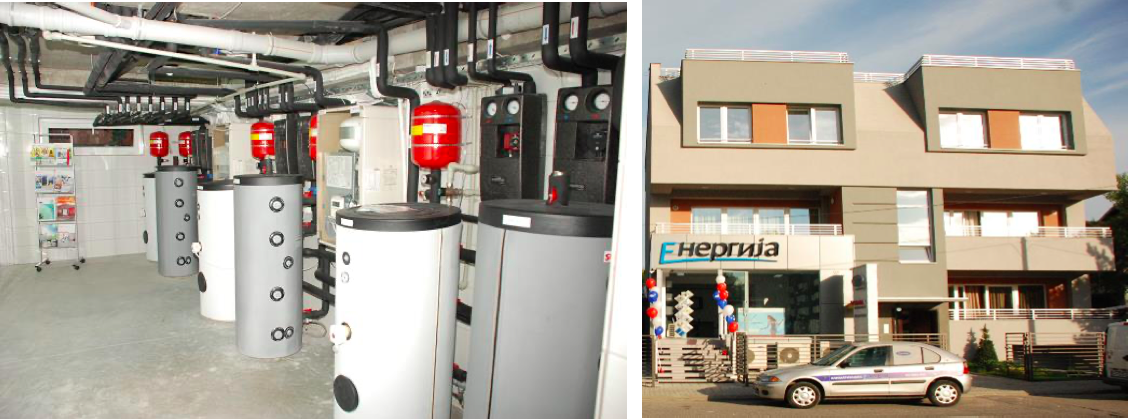Macedonia
2015
- Type : Project
- Size : Local community
- Area : Residential
Environmental benefit
Solar Heating and Cooling in an Energy Efficient Residential Building
Share
Macedonia
2015
- Type : Project
- Size : Local community
- Area : Residential
Environmental benefit
Discover this use case online

This heating and cooling system has been installed in a privately owned three story building – Energija – in the municipality of Karposh. Karposh is the only municipality in Macedonia which has subsidised the energy efficiency in buildings and the renewable energy use for heating and cooling, , covering 15% and 20% of the communal tax for the respective buildings. The ground level of the building is a commercial space while the levels above are residential apartments. The system has a variety of technologies among which are heat pumps, solar panels, fan coil units, underfloor heating and heat storage. As a result of the proper insulation, the annual energy consumption of the building is 29.6 kWh/m2 .
For the purpose of obtaining sanitary hot water, a solar-assisted air source heat pump is being used. The pump’s outer unit is a Toshiba Super Digital Inverter technology with high energy efficiency. The compressors inside the inverter are equipped with a variable speed motor capable of adjusting the rotational speed of the outdoor fans. This keeps the air moving at the desired velocity. Moreover, as the rotational speed of the fans decreases, the electricity consumption decreases as well, making the heat pump less energy demanding.
In order to increase the reliability of the system, buffers and boilers are installed. A boiler for the storage of sanitary hot water with a capacity of 200 litres is installed. This boiler is connected to the solar heating panel and the heat pump. Additionally, buffers for the heating and cooling needs are installed.
The space heating and cooling is directly achieved through fan coil units (FCUs). Depending on whether the area is being heated or cooled, hot or cold water circulates inside these convectors, respectively. The heat conversion is achieved with the use of a heat exchanger. The FCUs are able to operate under five different speed settings. Moreover, a group of units can be connected and controlled from one central controller.
The underfloor heating is a closed water pipe system connected to the heat pump. The maximum temperature of the water in the underfloor system should be 35 degrees Celsius, which happens to be the ideal working temperature of the heat pump. Consequently, the efficiency of the heat pump and the underfloor heating is high under these conditions.
The monitoring, control and supervision of space heating/cooling and/or heating of sanitary hot water, one control unit is being used. The control is achieved through valve control and temperature adjustment. A zone control system is applied as well, where separate areas of the building can be heated or cooled to different temperatures. Additionally, a working schedule can be set in the programmable thermostat. It can be concluded that the insulation plays an important role in the buildings’ efficiency and enhances the benefits from the heating and cooling system.
Source: Information on this page is retrieved from CoolHeating.
 R-ACES has received funding from the European Union’s Horizon 2020 research and innovation programme under grant agreement N° 892429
R-ACES has received funding from the European Union’s Horizon 2020 research and innovation programme under grant agreement N° 892429
This heating and cooling system has been installed in a privately owned three story building – Energija – in the municipality of Karposh. Karposh is the only municipality in Macedonia which has subsidised the energy efficiency in buildings and the renewable energy use for heating and cooling, , covering 15% and 20% of the communal tax for the respective buildings. The ground level of the building is a commercial space while the levels above are residential apartments. The system has a variety of technologies among which are heat pumps, solar panels, fan coil units, underfloor heating and heat storage. As a result of the proper insulation, the annual energy consumption of the building is 29.6 kWh/m2 .
For the purpose of obtaining sanitary hot water, a solar-assisted air source heat pump is being used. The pump’s outer unit is a Toshiba Super Digital Inverter technology with high energy efficiency. The compressors inside the inverter are equipped with a variable speed motor capable of adjusting the rotational speed of the outdoor fans. This keeps the air moving at the desired velocity. Moreover, as the rotational speed of the fans decreases, the electricity consumption decreases as well, making the heat pump less energy demanding.
In order to increase the reliability of the system, buffers and boilers are installed. A boiler for the storage of sanitary hot water with a capacity of 200 litres is installed. This boiler is connected to the solar heating panel and the heat pump. Additionally, buffers for the heating and cooling needs are installed.
The space heating and cooling is directly achieved through fan coil units (FCUs). Depending on whether the area is being heated or cooled, hot or cold water circulates inside these convectors, respectively. The heat conversion is achieved with the use of a heat exchanger. The FCUs are able to operate under five different speed settings. Moreover, a group of units can be connected and controlled from one central controller.
The underfloor heating is a closed water pipe system connected to the heat pump. The maximum temperature of the water in the underfloor system should be 35 degrees Celsius, which happens to be the ideal working temperature of the heat pump. Consequently, the efficiency of the heat pump and the underfloor heating is high under these conditions.
The monitoring, control and supervision of space heating/cooling and/or heating of sanitary hot water, one control unit is being used. The control is achieved through valve control and temperature adjustment. A zone control system is applied as well, where separate areas of the building can be heated or cooled to different temperatures. Additionally, a working schedule can be set in the programmable thermostat. It can be concluded that the insulation plays an important role in the buildings’ efficiency and enhances the benefits from the heating and cooling system.
